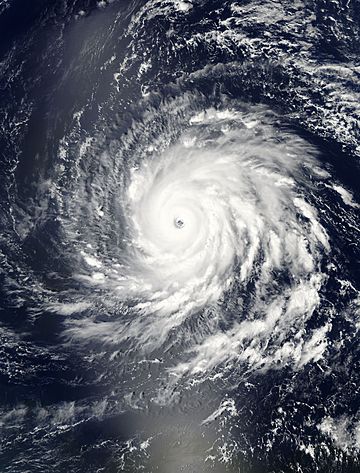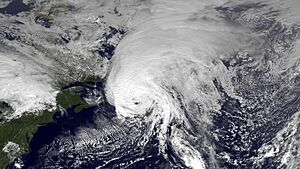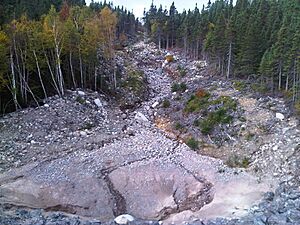Hurricane Igor facts for kids
| Category 4 major hurricane (SSHWS/NWS) | |

Hurricane Igor as a strong category 4 hurricane
|
|
| Formed | September 8, 2010 |
|---|---|
| Dissipated | September 21, 2010 |
| Highest winds | 1-minute sustained: 155 mph (250 km/h) |
| Lowest pressure | 924 mbar (hPa); 27.29 inHg |
| Fatalities | 4 direct |
| Damage | $200 million (2010 USD) |
| Areas affected | Cape Verde, Northeastern Caribbean, United States East Coast, Bermuda, Newfoundland, Saint Pierre and Miquelon |
| Part of the 2010 Atlantic hurricane season | |
Hurricane Igor was a very powerful and damaging tropical cyclone that traveled across the Atlantic Ocean in September 2010. It passed close to Bermuda and then hit the island of Newfoundland in Canada. At its strongest, Igor was a Category 4 hurricane with winds reaching 155 miles per hour (250 km/h).
When Igor passed by Bermuda, it was a weaker hurricane and caused only a small amount of damage. However, in Newfoundland, the storm caused about $200 million in damage. This made Igor the most destructive Atlantic tropical cyclone ever to hit that area. Because of the serious damage it caused, the name Igor was removed from the list of hurricane names and replaced with Ian for future storms.
Contents
What is a Hurricane?
A hurricane is a very strong type of tropical cyclone. These storms form over warm ocean waters. They have a low-pressure center, called an "eye," and strong winds that spiral around it. Hurricanes bring heavy rain, strong winds, and can cause large waves and storm surges. They are given names to help people track them and remember them.
Igor's Journey: From Ocean to Land
How Igor Formed and Grew
Hurricane Igor started as a tropical wave near the Cape Verde islands on September 8, 2010. As it moved west across the warm Atlantic Ocean, it quickly grew stronger. By September 12, Igor became a major hurricane, reaching Category 4 strength. This meant it had very powerful winds and was a serious threat.
Igor's Path Towards Bermuda
Igor continued to move across the ocean, heading towards the island of Bermuda. Forecasters watched it closely because of its strength. Even though it was a very strong storm, it began to weaken slightly as it got closer to Bermuda.
Igor's Impact on Bermuda
On September 19, Hurricane Igor passed just west of Bermuda. By this time, it had weakened to a Category 1 hurricane. Bermuda experienced strong winds and heavy rain.

The island saw some power outages and minor damage to trees and homes. Large waves, some as high as 15 feet (4.6 meters), hit the coast for several days. Luckily, the damage in Bermuda was not severe.
Igor's Impact on Newfoundland
Landfall and Widespread Damage
After passing Bermuda, Igor turned north and headed for Newfoundland, Canada. On September 21, Igor made landfall on the island as a strong extratropical cyclone. Even though it was no longer a tropical hurricane, it still brought immense power.
The storm caused widespread damage across eastern Newfoundland. Many roads and bridges were washed out by heavy rainfall and flooding. Power lines were knocked down, leaving thousands without electricity.
Flooding and Infrastructure Damage
The rainfall from Igor was extreme in some areas. Rivers and streams overflowed their banks, leading to major floods.
This flooding damaged homes, businesses, and important infrastructure. The total damage in Newfoundland was estimated at $200 million. This made Igor one of the most costly storms in the region's history.
After the Storm: Igor's Legacy
Because of the significant damage and impact it had, especially in Newfoundland, the name "Igor" was officially retired. This means that no future Atlantic tropical cyclone will be named Igor. This is a common practice for storms that cause a lot of destruction or loss of life. The name "Ian" was chosen to replace Igor on the list of hurricane names.
Images for kids
-
Photograph of Hurricane Igor's eye on September 14 from the International Space Station
-
Large waves impacted the coast of Bermuda for several days prior to and following Igor's passage, some of which were up to 15 feet (4.6 m) high.
See also
 In Spanish: Huracán Igor para niños
In Spanish: Huracán Igor para niños










